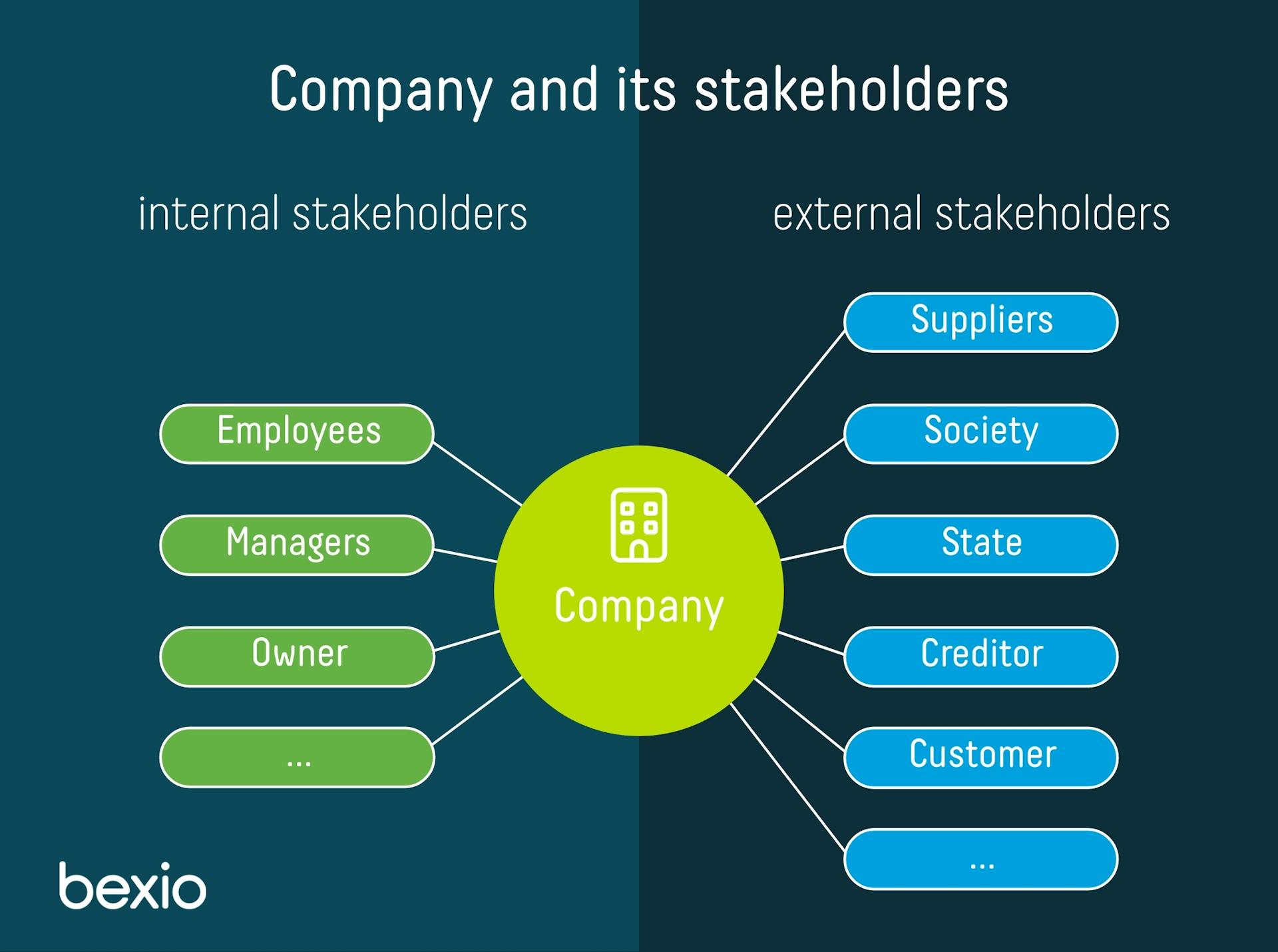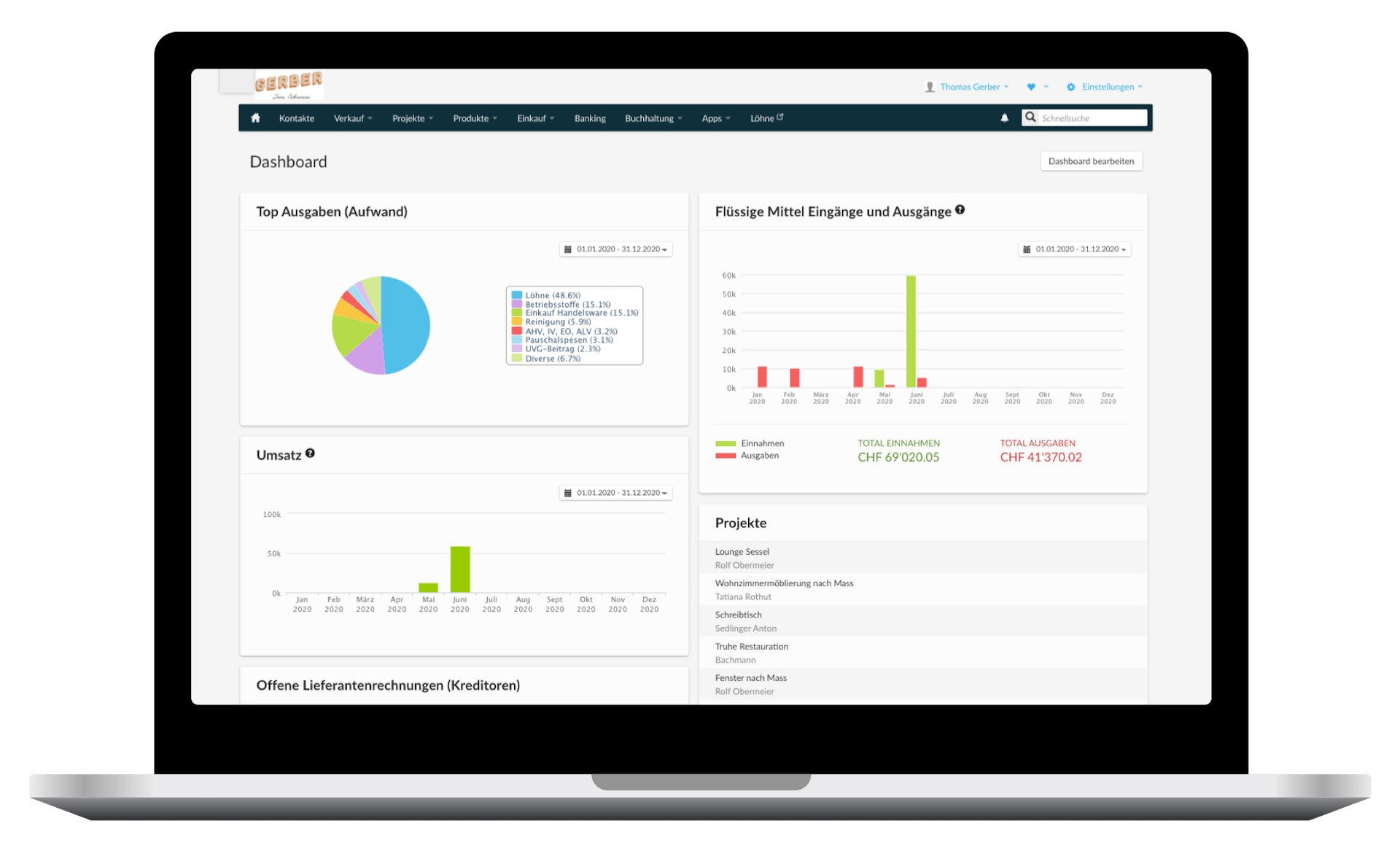Stakeholders are individuals or companies that have an interest in the success of a company or project. Stakeholders can be external or internal entities, such as suppliers (external) and employees (internal), who are actively involved in or influence company processes. In this post, we go into more detail and explain what exactly lies behind the term stakeholder.

What is a stakeholder?
Stakeholders are interest representatives for companies or projects. This means that they have an interest in the success of the company or a project and are actively (directly) or inactively (indirectly) involved in processes. For example, employees are internal stakeholders because their work contributes to the success of the company. Banks, on the other hand, are external stakeholders as lenders.
Who are typical stakeholders?
There are stakeholders that a company automatically has or does not have. In addition, the term stakeholder distinguishes between internal and external stakeholders. Typical stakeholders are customers, suppliers, lenders (such as banks), shareholders, partners, owners, associations, etc.
External stakeholders
As soon as a stakeholder outside the company has a relationship with it and a 'stake' in its success, it belongs to the group of external stakeholders. They do not directly affect the company's success or processes. These include, for example, banks, lenders, investors, shareholders, suppliers, partners, associations, the state and customers. For example, banks, as lenders, have an interest in the success of a company because they want their investment to be refinanced in the future.
Internal stakeholders
Internal stakeholders, on the other hand, are interest groups that directly influence processes and the success of the company. They include the owner, management and employees. Through their work, employees have a direct impact on the processes and thus the success of the company. They therefore belong to the internal stakeholders. The better the product produced, the higher the sales and the greater the likelihood of long-term, well-paid jobs.
Project stakeholders
There is also the designation of project stakeholders. This is the case when people or groups are only involved in a specific project. They are therefore interested in the positive outcome of the project and contribute to it. Everyone involved in the project usually has different interests and different stakes.
Stakeholders – a concrete example
Every company has them, regardless of size. Whether it is a sole proprietorship or a large company – every legal form has stakeholders. Let's take the following example: Your company manufactures ceramic products. This results in different stakeholders that have different stakes vis-à-vis your company.
Stakeholder | Stake | Influence |
Owner | Generate as much revenue and profit as possible. | Very high; as the owner, you control the processes and have the decision-making power. |
Employees | Long-term, well-paid job. | Medium – high; your business cannot function without trained and qualified employees. |
State | With more sales, the tax liability increases. | Fairly low; with correct accounting, your tax burden will also be calculated correctly. |
Customers | Good quality at a good price. | High; your customers are the most important stakeholders, as they ensure sales and thus your existence. |
Suppliers | The higher your turnover, the higher your order quantity and thus the turnover of the supplier. | Medium – high; depending on how many competitors there are, the impact on your ability to do business can be high. |

Why are stakeholders so important?
As a company, it is important to analyse and closely monitor stakeholders, since they contribute to the success of the company. Stakeholders' stakes are not static and can change over time.
Customers, for example, are interested in products that are inexpensive and high quality. If your company suddenly no longer serves the interest of your customers, this can lead to a drop in sales. So it should be in your interest as the owner to keep prices competitive in order to secure your revenue (your stake) and continue to retain your customers (external stakeholders).
Employees, on the other hand, want good working conditions and wages in line with the market. If your company doesn't meet that, you may lose your workforce and be unable to meet market demand, resulting in lower revenue.
As you can see, the stakeholders affect the company and the company affects the respective stakeholders. The success or failure of an enterprise thus also depends on these interrelationships. It is therefore important to monitor these relationships and intervene when needed in order to continue to benefit from them and guarantee the success of the company.
Stakeholders that every company has:
- Owner
- Employees
- Customers
- State
- Institutions (e.g. environmental requirements in production)
Stakeholders* that are optional:
- Shareholders (only for stock companies)
- Banks and lenders
- Associations
- Suppliers
- Management
* Non-exhaustive list
How do I identify stakeholders?
To serve the interests of your stakeholders, you must first identify them. Subsequent categorisation is recommended in order to keep a close eye on the important, i.e. influential, stakeholders. The higher their influence, the faster a mismatch could harm you and your company.

To identify your stakeholders, it is advisable to start with the internal ones. These result from your organisational chart and can therefore be determined quickly.
In the next step, turn your gaze outwards. Of course, external stakeholders primarily include your customers, who secure your existence by buying your products or services. The state is also one of the secure external stakeholders, since you have a tax burden towards it through your business activities. Next, make a note of lenders, such as banks or creditors, if such a relationship exists. This also includes landlords, electricity and telephone providers, etc. Make a note of who you owe money to. So your list usually fills up pretty quickly.
Next, you should categorise your stakeholders – ideally starting with those who have the most influence on your business (e.g. customers) down to those with the least influence (e.g. the phone provider is not vitally important for most companies).
A sample table for identification and categorisation
Stakeholder / stakeholder group | Stake | Influence | Frequency of analysis |
Customers | Good quality at low prices. | High; your existence depends on the sale of your products/services. | Regularly throughout the year (Are market demands changing? Are there new competitors?) |
Employees | Good working conditions, fair pay. | Medium – high; without employees you cannot sell your goods and it is difficult to do business. | Every 1-2 years |
etc. |
Your company at a glance with bexio
Whether you need to conduct stakeholder analyses or make important decisions, bexio business software lets you keep an eye on your company. From your company's financial situation, to your customers, to internal and external projects: bexio organises all company-relevant information in one piece of software.
Frequently asked questions about stakeholders
As explained above, stakeholders are interest groups that have an interest in and influence company activities. Shareholders are people who have a stake in the company's equity and hold shares in it.
The most important and influential stakeholders include customers, employees, the owner, the state and lenders.
The stakeholder value corresponds to the value of the company, which all stakeholder groups have a stake in. The company must therefore try to satisfy all stakes in the best possible way so the stakeholders get their value back.
With the stakeholder approach, all stakeholder stakes are integrated into the business policy in order to fulfil them in the best possible way. In contrast to the shareholder approach, all stakeholders are taken into account here and not only the shareholders. This means that with the stakeholder approach, many more influences have to be considered when planning actions and processes.
Stakeholders are interested in ensuring that their stakes are taken into account by the company in its business policy and, ideally, are met (e.g. environmental requirements). In addition, most stakeholders pursue financial goals. The expectations differ depending on the interest group. Customers, for example, expect a competitive pricing policy, employees expect good remuneration, while banks expect creditworthiness.
Stakeholder management has the task of serving the stakes of all interest groups and thus building good interrelationships to ensure the long-term success of the company.
Test out bexio now for 30 days free of charge and with no obligation
Test all the features of bexio, the simple business software for your SME administration.





